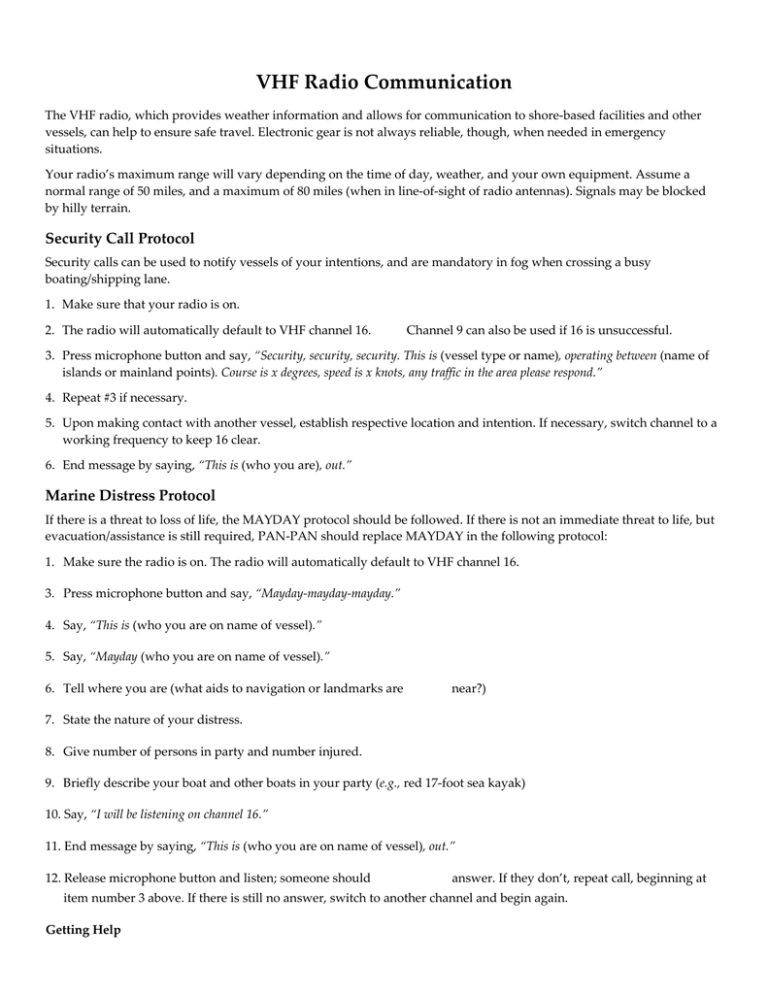VHF Radio Communication
advertisement

VHF Radio Communication The VHF radio, which provides weather information and allows for communication to shore‐based facilities and other vessels, can help to ensure safe travel. Electronic gear is not always reliable, though, when needed in emergency situations. Your radio’s maximum range will vary depending on the time of day, weather, and your own equipment. Assume a normal range of 50 miles, and a maximum of 80 miles (when in line‐of‐sight of radio antennas). Signals may be blocked by hilly terrain. Security Call Protocol Security calls can be used to notify vessels of your intentions, and are mandatory in fog when crossing a busy boating/shipping lane. 1. Make sure that your radio is on. 2. The radio will automatically default to VHF channel 16. Channel 9 can also be used if 16 is unsuccessful. 3. Press microphone button and say, “Security, security, security. This is (vessel type or name), operating between (name of islands or mainland points). Course is x degrees, speed is x knots, any traffic in the area please respond.” 4. Repeat #3 if necessary. 5. Upon making contact with another vessel, establish respective location and intention. If necessary, switch channel to a working frequency to keep 16 clear. 6. End message by saying, “This is (who you are), out.” Marine Distress Protocol If there is a threat to loss of life, the MAYDAY protocol should be followed. If there is not an immediate threat to life, but evacuation/assistance is still required, PAN‐PAN should replace MAYDAY in the following protocol: 1. Make sure the radio is on. The radio will automatically default to VHF channel 16. 3. Press microphone button and say, “Mayday‐mayday‐mayday.” 4. Say, “This is (who you are on name of vessel).” 5. Say, “Mayday (who you are on name of vessel).” 6. Tell where you are (what aids to navigation or landmarks are near?) 7. State the nature of your distress. 8. Give number of persons in party and number injured. 9. Briefly describe your boat and other boats in your party (e.g., red 17‐foot sea kayak) 10. Say, “I will be listening on channel 16.” 11. End message by saying, “This is (who you are on name of vessel), out.” 12. Release microphone button and listen; someone should answer. If they don’t, repeat call, beginning at item number 3 above. If there is still no answer, switch to another channel and begin again. Getting Help If you are in trouble and need help, here is a quick checklist of agencies and groups of people who may come to your aid: Cruising Boats. The closest and fastest source of help is probably another cruising boat. Lobster boats. Don’t trouble lobstermen for trivial assistance, but do yell or flag them if you are in real trouble. In bad weather or poor visibility, you may have to use your VHF radio. Lobstermen don’t routinely monitor channel 16 so switch around until you find the local channel that appears to have fishing chatter. Boatyards. Many yards have powerboats that can lend assistance, usually for a fee. U.S. Coast Guard. There are six Coast Guard stations in Maine: South Portland, Boothbay Harbor, Rockland, Southwest Harbor, Jonesport, and Eastport, plus one in Portsmouth, New Hampshire. Each small boat station always has at least one boat ready to proceed within 30 minutes. In summer, one patrol cutter is either underway off the Maine coast or on standby to proceed within two hours of notification. This cutter may be anywhere between Portsmouth, New Hampshire, and Eastport, Maine. For help, call the nearest Coast Guard station on channel 16 of your VHF. After contact on 16, use the emergency distress protocols previously listed and follow any directions they give you over the radio. The Coast Guard will prioritize saving human life over protecting property. The Coast Guard may not dispatch boats in non‐emergency cases where commercial entities are available, willing, and qualified to assist. In cases where a private firm does assist, the Coast Guard will monitor the situation to completion by means of a radio schedule. The Marine Patrol. The State’s Marine Patrol shares many of the same enforcement and rescue responsibilities as the Coast Guard. When you contact the Coast Guard via channel 16, they will decide whether the situation should be handled by the Marine Patrol. In general, the Marine Patrol is responsible for enforcing State, rather than Federal, boating and fishing laws. Town Rescue Services. Some coastal towns have rescue boats operated by police or fire departments. Marine VHF Radio Channels Make contact on Channel 16. Use your boat’s name and call number, then switch to one of the following working channels: Boat to Boat or Shore – 9, 68, 69, 71, ,72, 78 U.S. Coast Guard – 16, 22A Port Operations – 20, 65A, 66A, 73, 74 Navigation & Bridges – 13 Marinas – 12 Ship to Ship Safety – 6 Weather Reports (receive only) – Wx1‐Wx7






